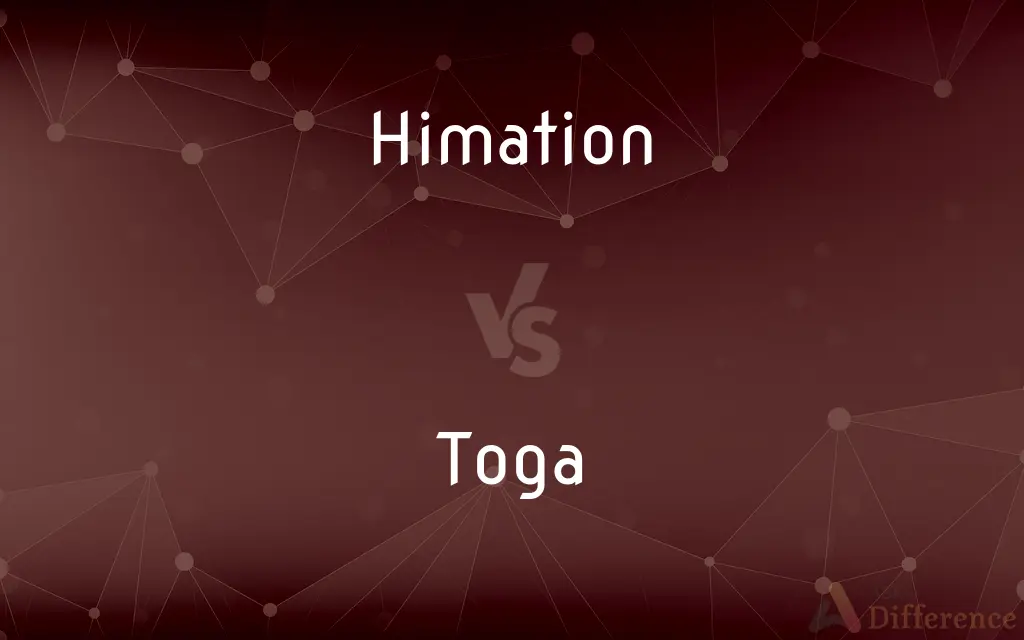Himation vs. Toga — What's the Difference?
Edited by Tayyaba Rehman — By Urooj Arif — Updated on April 2, 2024
Himation was a simple cloak worn in ancient Greece, while the toga was a distinctive garment of ancient Rome, symbolizing citizenship.

Difference Between Himation and Toga
Table of Contents
ADVERTISEMENT
Key Differences
The himation, originating from ancient Greece, was a rectangular piece of cloth draped over the left shoulder and wrapped around the body. It was typically worn over a chiton and could be adjusted to cover the head in inclement weather. On the other hand, the toga, synonymous with ancient Rome, was a large semicircular cloth that required complex draping and was often seen as a status symbol, denoting Roman citizenship.
While the himation was made of lighter materials and worn for both daily activities and formal occasions without any specific societal implications, the toga was heavier, made of wool, and reserved for citizens. The toga's complexity and the skill required to wear it correctly reflected the wearer's social status and wealth.
The himation allowed for more freedom of movement due to its simpler design and lighter fabric, making it suitable for the Greek climate and lifestyle, which included activities such as athletics and outdoor gatherings. Conversely, the toga, with its elaborate draping and heavier material, was more restrictive but served as a formal garment for public and political events in Rome.
Another notable difference lies in the variation and adaptation of the garments. The himation remained relatively unchanged over centuries, emphasizing functionality and simplicity. In contrast, the toga evolved, with versions like the toga praetexta (bordered with purple and worn by magistrates and freeborn boys) and the toga virilis (the plain toga of a Roman man), showcasing Rome's complex social hierarchy.
Both the himation and the toga declined in use as the Roman Empire embraced more practical clothing from other cultures, but they remain iconic symbols of their respective civilizations, reflecting the values, climate, and social structures of ancient Greece and Rome.
ADVERTISEMENT
Comparison Chart
Origin
Ancient Greece
Ancient Rome
Material
Light fabrics (e.g., linen, wool)
Heavy wool
Wearers
Greeks; no citizenship requirement
Roman citizens only
Usage
Daily wear and formal occasions
Formal and public events
Design
Rectangular cloth, draped over the shoulder
Semicircular cloth, complex draping required
Symbolism
None specific; practical garment
Symbol of Roman citizenship and social status
Variations
More uniform with fewer variations
Several variations indicating status and age
Movement
Allows freedom of movement
Restrictive due to elaborate draping
Compare with Definitions
Himation
A simple rectangular cloak from ancient Greece, worn draped over one shoulder.
The philosopher walked through the marketplace, his himation wrapped loosely around his body.
Toga
Underwent stylistic evolutions, reflecting changes in Roman society and culture.
The wider his toga, the more respect it commanded in the Senate.
Himation
Typically worn over a chiton, providing flexibility and ease.
Athletes at the gymnasium often wore only a himation after their exercises.
Toga
Required intricate folding and was exclusive to citizens, denoting status.
His toga praetexta, edged with purple, marked him as a man of authority.
Himation
Remained consistently simple throughout Greek history.
Even in times of wealth, the himation stayed true to its basic, functional design.
Toga
Seen as a symbol of Rome itself, embodying the empire's values and prestige.
Wearing a toga in the forum, he felt the weight of Roman tradition on his shoulders.
Himation
Favored for its adaptability to different weather conditions.
On cooler days, he would pull his himation closer, covering his head.
Toga
A garment symbolizing Roman citizenship, made of a large semicircular piece of cloth.
The senator stood proudly in his toga, ready to address the public assembly.
Himation
A himation (Ancient Greek: ἱμάτιον hə-MAT-ee-un) was a type of clothing, a mantle or wrap worn by ancient Greek men and women from the Archaic through the Hellenistic periods (c. 750–30 BC).
Toga
The toga (, Classical Latin: [ˈt̪ɔ.ɡa]), a distinctive garment of ancient Rome, was a roughly semicircular cloth, between 12 and 20 feet (3.7 and 6.1 m) in length, draped over the shoulders and around the body. It was usually woven from white wool, and was worn over a tunic.
Himation
A rectangular woolen or linen cloak worn by men and women in ancient Greece.
Toga
A loose flowing outer garment worn by the citizens of ancient Rome, made of a single piece of cloth and covering the whole body apart from the right arm.
Himation
(historical) A rectangular cloak of linen or wool, worn in Ancient Greece, usually over a chiton.
Toga
A loose one-piece outer garment worn in public by male citizens in ancient Rome.
Toga
A robe of office; a professional or ceremonial gown.
Toga
A loose outer garment worn by the citizens of Ancient Rome.
Toga
A loose wrap gown.
Toga
(Philippines) An academic gown.
Toga
The loose outer garment worn by the ancient Romans, consisting of a single broad piece of woolen cloth of a shape approaching a semicircle. It was of undyed wool, except the border of the toga prætexta.
Toga
A one-piece cloak worn by men in ancient Rome
Common Curiosities
What was the primary function of the himation?
The himation served both practical and aesthetic purposes, providing warmth and modesty while being adaptable for various social situations.
What is a himation?
A himation is a rectangular piece of cloth from ancient Greece, worn draped over the shoulder and around the body, often over a chiton.
How did the design of the himation compare to the toga?
The himation was simpler, requiring less fabric and no specialized knowledge to wear, whereas the toga required elaborate draping and was much bulkier.
Were there any restrictions on who could wear a toga?
Yes, wearing a toga was restricted to Roman citizens, and different types of togas indicated the wearer's age, status, and office.
How did the climate influence the design of the himation and toga?
The lighter materials of the himation suited the warmer, Mediterranean climate of Greece, while the heavier wool toga was adapted for the cooler Roman climate.
What led to the decline of the toga in Roman society?
The decline of the toga came with the changing fashion and practical needs of the late Roman Empire, including the adoption of more comfortable and less cumbersome clothing.
What is the difference between a chiton and a himation?
A chiton was a type of tunic that served as the primary garment in ancient Greece, often worn under the himation, which was a cloak.
Why was the toga important in Roman society?
The toga was a symbol of Roman citizenship, legal adulthood for males, and social status, integral to public and political life.
Could women wear the himation or toga?
Women in ancient Greece could wear the himation, but in Rome, the toga was primarily a male garment, with women having their own distinct attire, like the stola.
What distinguishes a toga?
The toga is a distinctive semicircular garment of ancient Rome, symbolizing citizenship and worn in a complex style around the body.
Did the himation have any variations?
The himation was relatively uniform with minimal variations, emphasizing its role as a versatile garment.
How was the himation worn during different activities?
The himation could be adjusted for comfort and modesty, easily adapted for various activities from daily chores to formal gatherings.
What societal values did the toga represent?
The toga represented Roman values of citizenship, social hierarchy, and public dignity, playing a key role in the civic and political identity of Rome.
Could a non-citizen in Rome wear a toga?
No, non-citizens were not permitted to wear the toga, as it was a symbol of Roman citizenship and legal status.
Share Your Discovery

Previous Comparison
Finalisation vs. Finalization
Next Comparison
Hamlet vs. SettlementAuthor Spotlight
Written by
Urooj ArifUrooj is a skilled content writer at Ask Difference, known for her exceptional ability to simplify complex topics into engaging and informative content. With a passion for research and a flair for clear, concise writing, she consistently delivers articles that resonate with our diverse audience.
Edited by
Tayyaba RehmanTayyaba Rehman is a distinguished writer, currently serving as a primary contributor to askdifference.com. As a researcher in semantics and etymology, Tayyaba's passion for the complexity of languages and their distinctions has found a perfect home on the platform. Tayyaba delves into the intricacies of language, distinguishing between commonly confused words and phrases, thereby providing clarity for readers worldwide.
















































